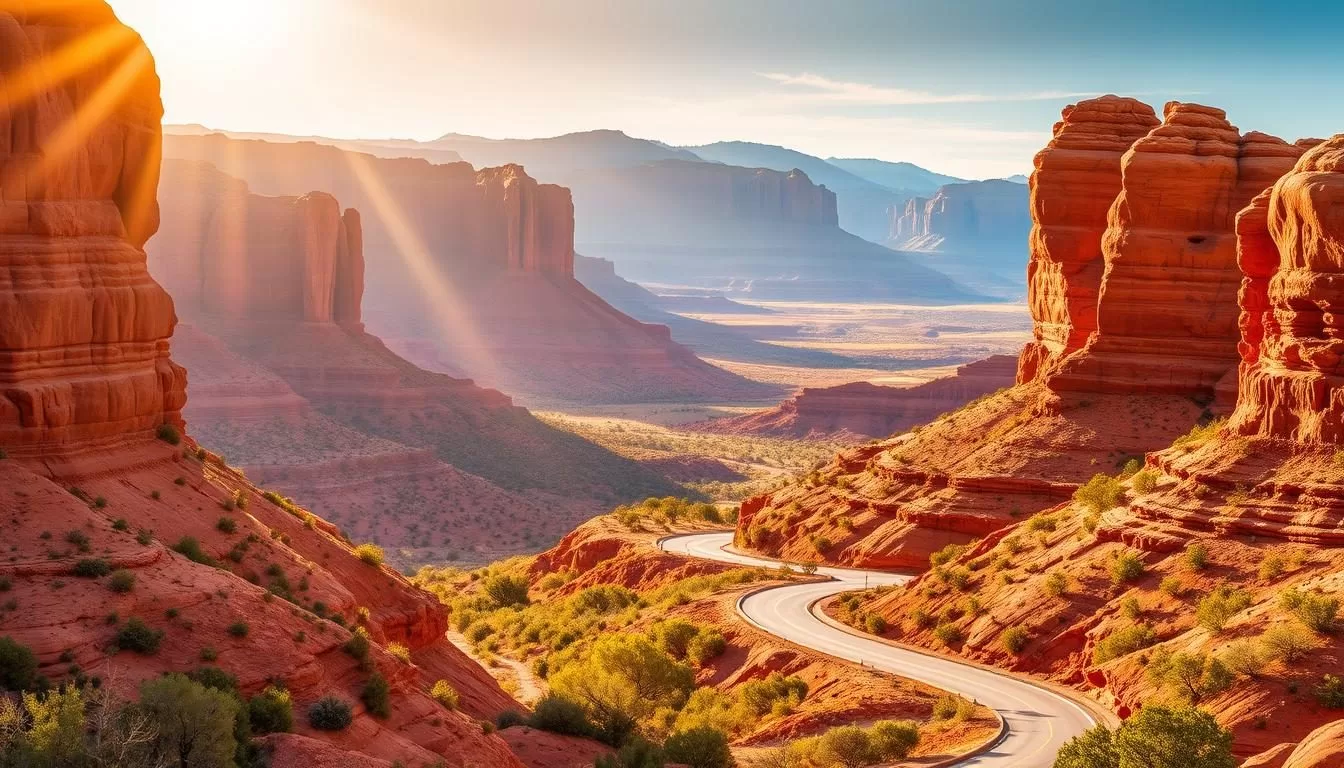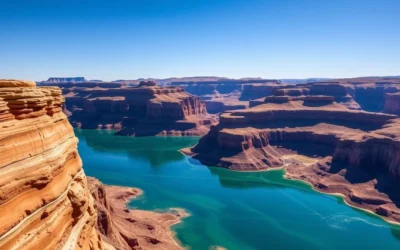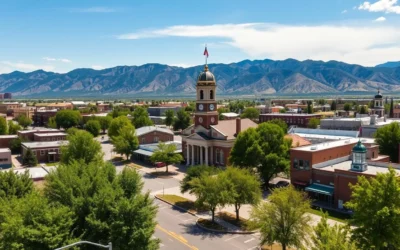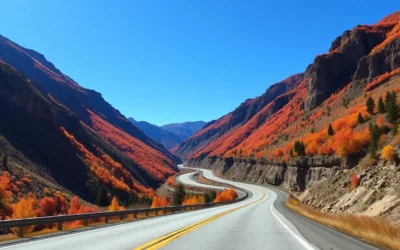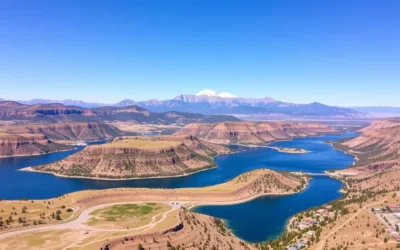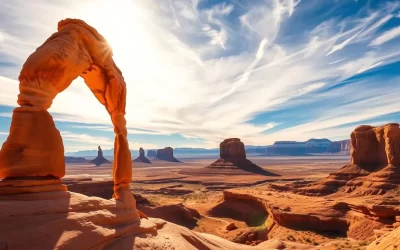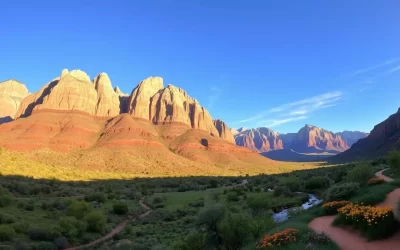Discover the hidden gem of Utah’s national parks, where stunning landscapes await without the crowds. Capitol Reef National Park is a treasure trove of natural wonders, featuring a scenic drive, hiking trails, rugged areas to explore, and historical landmarks.
The park’s unique Waterpocket Fold, a 100-mile long wrinkle in the Earth’s crust, is a must-see geological feature. With its rich history and diverse landscapes, you’ll experience massive sandstone domes, narrow slot canyons, and colorful cliffs. This guide will walk you through the top experiences, from must-see landmarks to hidden gems, to plan your perfect visit.
Discovering Capitol Reef National Park
As one of Utah’s most stunning natural wonders, Capitol Reef National Park beckons adventurers and nature lovers alike. Located in south-central Utah, this national park is a treasure trove of natural beauty and fascinating geological formations. Capitol Reef is characterized by its unique name, derived from the white domes of Navajo sandstone resembling the United States Capitol building and the “reef” part coming from the long ridges of the Waterpocket Fold that early settlers found impassable, much like reefs in the ocean.
What Makes Capitol Reef Unique
Capitol Reef National Park stands out due to its extraordinary geological features. The park is very long and skinny, running in a north-south direction, measuring 60 miles long and only 6 miles wide on average. This unique landscape is a result of the Waterpocket Fold, a 100-mile long “wrinkle” in the Earth’s crust.
The park’s distinctiveness is further highlighted by its rich cultural history and the variety of flora and fauna that inhabit this remarkable landscape.
The Waterpocket Fold: A Geological Wonder
The Waterpocket Fold is a significant geological feature that formed 50-70 million years ago due to tectonic forces pushing up layers of rock. This massive monocline created a dramatic landscape where the western side was lifted 7,000 feet higher than the eastern side. The “waterpocket” name is derived from the numerous small depressions in the sandstone that collect rainwater, vital for indigenous peoples and early explorers.
Erosion has carved this geological wonder over millions of years, revealing colorful layers of rock that represent over 200 million years of Earth’s history. As you explore Capitol Reef, you’ll witness this remarkable formation from various vantage points, each offering a different perspective on this massive geological wonder.
Planning Your Visit to Capitol Reef
Planning a trip to Capitol Reef National Park requires some insider knowledge to ensure you don’t miss out on its hidden gems. With its unique landscapes and diverse outdoor activities, Capitol Reef National Park is a must-visit destination in Utah.
Best Time to Visit
The best time to visit Capitol Reef National Park is from spring to fall, when the weather is mild and ideal for outdoor activities. Summer can be hot, so be sure to pack accordingly and stay hydrated. If you’re looking for fewer crowds, consider visiting during the shoulder season.
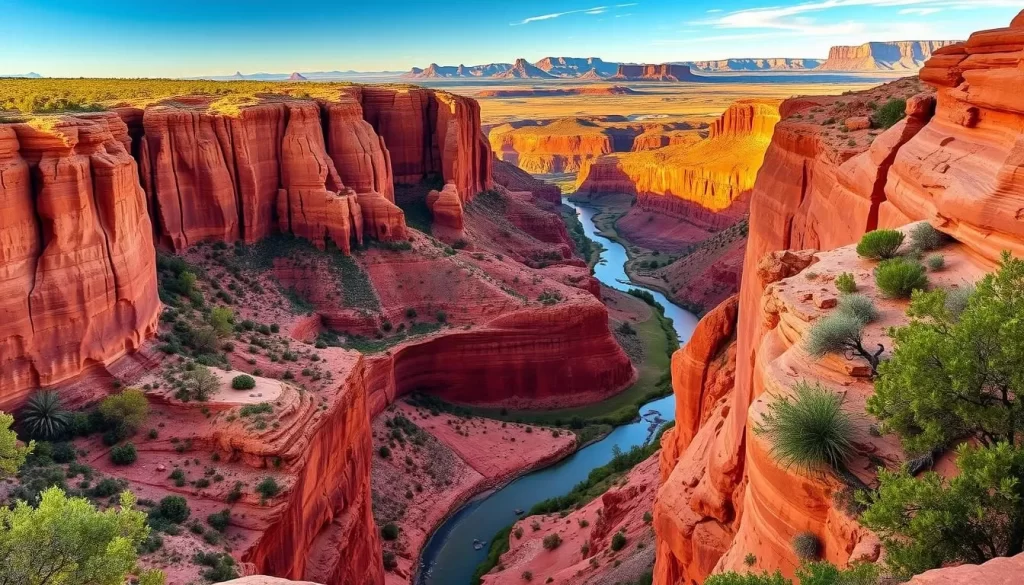
Park Fees and Passes
To enter Reef National Park, you’ll need to pay an entrance fee. The park offers various passes, including a single-day pass and an annual pass. If you plan to visit multiple national parks within a year, consider purchasing an America the Beautiful annual pass, which grants access to more than 2,000 recreation areas.
How Many Days to Spend
On average, 1-3 days will cover quite a bit in this small park. However, you can easily spend 5-7 days here if you want to explore the backcountry 4WD roads and the hikes that accompany them. Here’s a breakdown of what you can expect to do in different amounts of time:
- One full day: Drive the Scenic Drive, visit the historic Fruita district, and complete 1-2 shorter hikes like Hickman Bridge and Grand Wash.
- Two to three days: Explore the main attractions, add some moderate hikes like Cassidy Arch and Cohab Canyon, and enjoy sunrise or sunset at the park’s scenic viewpoints.
- Four to five days: Experience the remote Cathedral Valley and/or Loop the Fold backcountry drives, which require high-clearance vehicles and full days to explore.
Exploring the Historic Fruita District
Your journey through Capitol Reef National Park isn’t complete without exploring the historic Fruita District. This charming area is the heart of the park, where you’ll find the visitor center, the start of several great hikes, campgrounds, and historic buildings that tell the story of early settlers.
The Fruita District is known for its lush orchards and the opportunity to pick fresh fruit, making it a delightful stop for families and nature lovers alike.
Orchards and Fruit Picking
One of the joys of visiting the Fruita District is experiencing its orchards. The district is famous for its fruit trees, including cherry, apple, and peach trees. Visitors can pick fresh fruit, depending on the season, offering a unique and memorable experience. The orchards are a testament to the ingenuity of the early settlers who engineered sophisticated irrigation systems to bring life to this desert valley.
Historic Buildings and Sites
The historic buildings and sites within the Fruita District provide a glimpse into the lives of the pioneers who settled this remote area. Notable sites include the Fruita Schoolhouse, built in 1896, which served as the educational center for the community’s children. The Gifford Homestead, constructed in 1908, is another significant landmark, now functioning as a museum and store where you can taste the famous pies and buy handmade crafts. The distinctive red Fruita barn is one of the most photographed structures in Reef National Park, symbolizing the pioneer heritage of Capitol Reef. Walking through the district, you’ll also discover several historic irrigation systems that still function, demonstrating the settlers’ resourcefulness.
Exploring the historic Fruita District is like stepping back in time, offering a unique perspective on the challenges and rewards faced by the early inhabitants of this beautiful national park. With its rich history, picturesque landscapes, and the opportunity to engage with nature, the Fruita District is a must-visit destination when in Capitol Reef National Park.
Must-Try: Pie at the Gifford Homestead
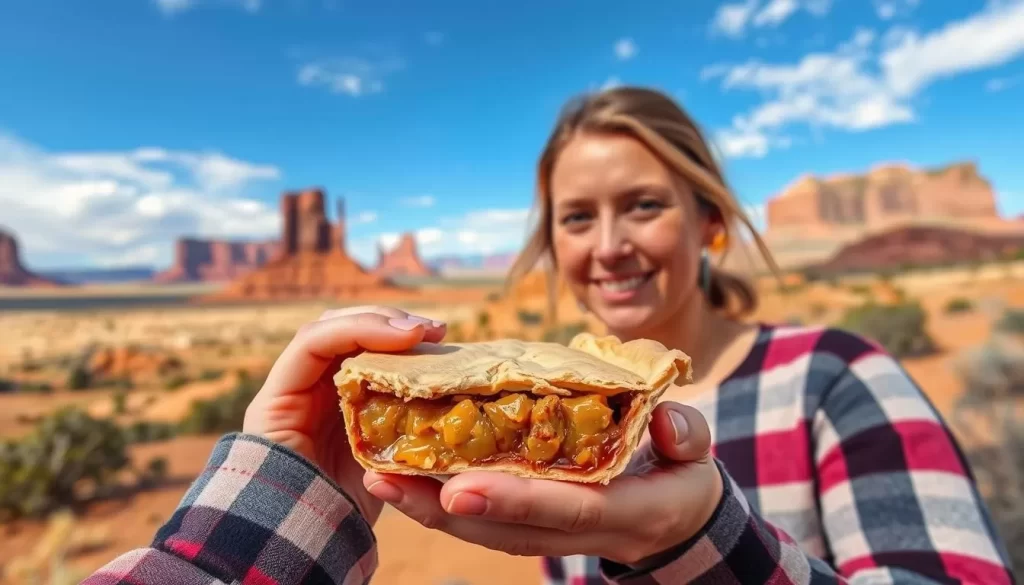
A visit to Capitol Reef National Park is incomplete without savoring the legendary pies at the Gifford Homestead, a treat that combines the park’s rich history with its bountiful orchards. The Gifford Homestead is a must-visit destination for anyone exploring the historic Fruita District.
A Brief History of the Gifford House
The Gifford Homestead, part of the historic Fruita District in Capitol Reef National Park, has been a cornerstone of the park’s culinary experience. Established in the early 20th century, the Gifford House has been serving visitors with homemade delights, including their now-famous pies, made from fruits grown in the park’s own orchards.
The homestead is a testament to the resourcefulness and hospitality of the Gifford family, who settled in this beautiful yet remote area of Utah. Their legacy lives on through the pies and other baked goods that continue to attract visitors from all over the world.
Best Pie Flavors and Treats
The pies at Gifford Homestead have achieved legendary status among park visitors, with many planning their entire Capitol Reef itinerary around ensuring they get a slice before they sell out for the day. Seasonal fruit pies feature fruits grown in the very orchards you can explore in the park, creating a farm-to-table experience that connects you directly to the land’s bounty.
Popular flavors include strawberry-rhubarb, mixed berry, cherry, and apple, with the selection varying based on what’s in season in the Fruita orchards. Beyond pies, don’t miss the fresh-baked cinnamon rolls, fruit scones, and homemade ice cream that pair perfectly with your pie slice for a complete indulgence.
For a perfect Capitol Reef experience, purchase a pie and enjoy it at the picnic area across from the Gifford Homestead, where you can savor your treat with views of the towering red cliffs and historic orchards.
Capitol Reef National Park, Utah: Best Things to Do – Top Picks
As you explore Capitol Reef National Park, you’ll uncover the best things to do in this breathtaking Utah destination. The park offers a mix of scenic drives, hiking trails, and historic sites that cater to different interests and fitness levels.
Scenic Drives
One of the best ways to experience Capitol Reef National Park is through its scenic drives. The park’s scenic drives offer breathtaking views of the unique landscapes and geological formations. You can drive through the park’s main scenic drive, which takes you through a variety of landscapes, from narrow canyons to broad valleys.
The scenic drives are not just about the destination; the journey itself is a significant part of the experience. You’ll have opportunities to stop at viewpoints, take short walks, and enjoy the scenery.
| Scenic Drive | Distance | Features |
|---|---|---|
| Capitol Reef Scenic Drive | 7.9 miles one-way | Historic Fruita District, orchards, and scenic viewpoints |
| Notom-Bullfrog Road | Not specified | Access to remote areas, including Cathedral Valley |
Best Hiking Trails
For those who love hiking, Capitol Reef National Park offers over 15 day hikes near the Fruita district alone, ranging from easy walks to challenging all-day adventures. Some of the most popular hikes include:
- Hickman Bridge Trail (1.8 miles round-trip): A moderate hike leading to a spectacular 133-foot natural bridge.
- Cassidy Arch Trail (3.4 miles round-trip): A challenging hike that offers dramatic views from atop a massive natural arch.
- Grand Wash (4.8 miles round-trip): A scenic hike through a canyon with walls towering up to 400 feet high.
- Navajo Knobs Trail (9.5 miles round-trip): A challenging hike to one of the highest points in the park, offering 360-degree vistas.
These trails offer a glimpse into the park’s diverse landscapes and geological wonders.
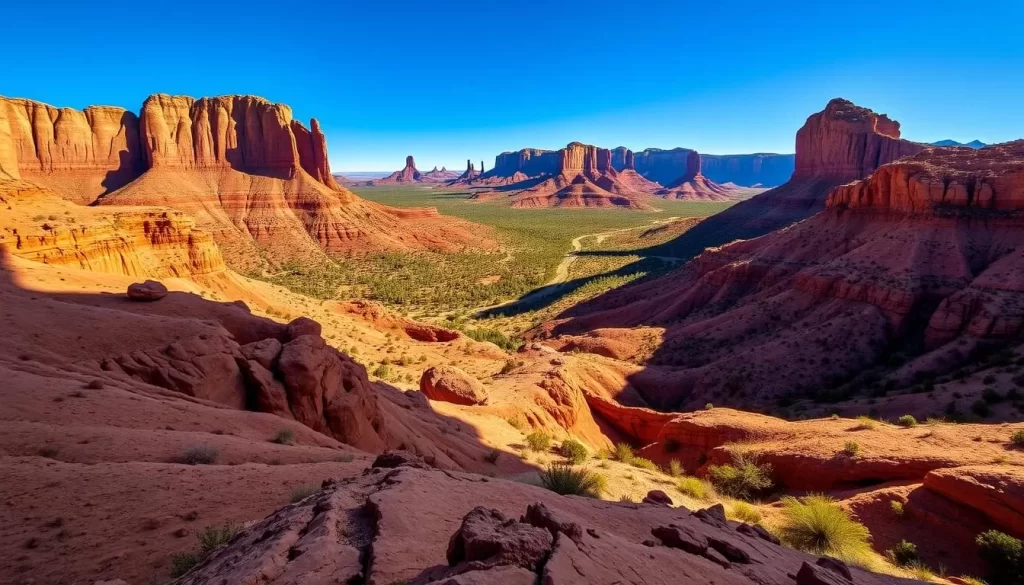
Highway 24: The Main Scenic Route
Your journey through Capitol Reef National Park is not complete without taking a drive along Highway24, the park’s main scenic route. This highway is the backbone of the park, providing access to many of its most spectacular sights and attractions. As you drive, you’ll be treated to breathtaking views of the surrounding landscape.
Key Viewpoints Along Highway24
As you travel along Highway24, be sure to stop at the designated viewpoints to take in the stunning vistas. One of the most notable stops is the Petroglyph Panel, where you can see ancient rock art created by the Fremont and Ancestral Puebloan people.
This short, wheelchair-friendly boardwalk leads to a viewpoint where you can observe these intricate carvings up close. The panel features a collection of petroglyphs that tell the story of the people who once inhabited this region.
Accessible Attractions from the Highway
Several of Capitol Reef’s most popular attractions are easily accessible directly from Highway24. The Hickman Bridge trailhead, located right off the highway, provides access to a popular hike leading to a spectacular 133-foot natural bridge.
You can also visit the historic Fruita Schoolhouse and Gifford Homestead, offering insights into the lives of the pioneers who settled in this remote valley. Additionally, picnic areas along the Fremont River provide pleasant spots to relax and enjoy the scenery.
Capitol Reef Scenic Drive and Capitol Gorge
One of the highlights ofCapitol Reef National Parkis the scenic drive that takes you through some of the park’s most stunning landscapes. This drive is a must-do experience when visiting the park, offering breathtaking views and access to various attractions.
Highlights of the Scenic Drive
TheCapitol Reef Scenic Driveis a pivotal part of any visit toReef National Park. As you drive through the park, you’ll be treated to spectacular vistas of the surrounding landscape. The drive takes you through a diverse range of geological formations, showcasing the park’s unique natural beauty. Be sure to stop at the various viewpoints and take in the breathtaking views.
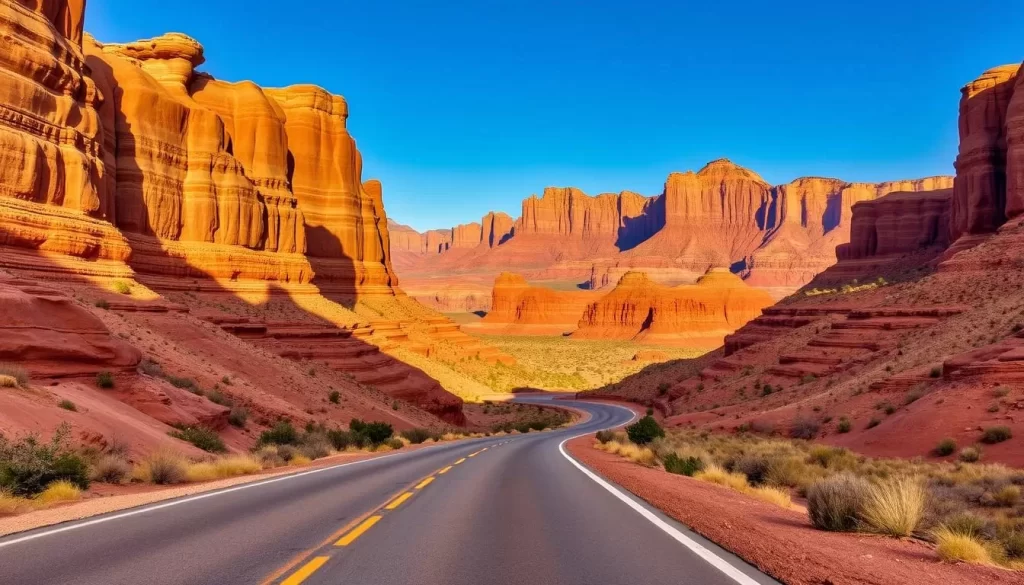
Capitol Gorge Road and Pioneer Register
At the end of the Scenic Drive, you’ll find the Capitol Gorge Road, a 2.3-mile unpaved spur road that leads you through a narrow canyon. This road was once the main route through the Waterpocket Fold before Highway 24 was constructed. The road is suitable for standard passenger vehicles in dry conditions but should be avoided during or after rain due to flash flood danger. As you explore the Capitol Gorge, you’ll come across thePioneer Register, a collection of names carved into the canyon walls by early settlers and travelers. The trail continues to “The Tanks,” natural water pockets that collected rainwater and served as vital water sources for travelers.
TheCapitol Gorgearea is not only significant for its historical importance but also for its natural beauty. Be sure to respect the area by not writing on the canyon walls, as it is under surveillance by the national park service.
Best Hiking Trails for Beginners
Discover the beauty of Capitol Reef National Park through its beginner-friendly hiking trails, perfect for those looking to explore nature. The park offers several trails that are ideal for those new to hiking or looking for a more leisurely experience.
Hickman Bridge Trail
The Hickman Bridge Trail is a 2-mile round-trip hike that leads to a natural bridge, a prominent feature within the park. This trail is considered moderate but is often recommended for beginners due to its well-maintained path and significant reward. The trailhead is accessible from the Scenic Drive, and the hike offers stunning views of the surrounding landscape.
Grand Wash Trail
The Grand Wash Trail offers an easy 4.8-mile round-trip hike through a spectacular canyon with towering walls that narrow to just 16 feet wide in some sections. You can access the trail from two trailheads: one off Highway 24 and another from the Scenic Drive, allowing for a point-to-point hike or an out-and-back from either end. Unlike similar slot canyon experiences in Zion National Park, Grand Wash typically stays dry, making it accessible without specialized gear or water shoes.
| Trail Name | Distance | Difficulty |
|---|---|---|
| Hickman Bridge Trail | 2 miles | Moderate |
| Grand Wash Trail | 4.8 miles | Easy |
Both trails offer unique experiences and are suitable for families with children or those looking for an easier hiking experience that still showcases Capitol Reef’s dramatic geology.
Moderate Hikes with Spectacular Views
If you’re seeking adventure in Capitol Reef National Park, consider tackling one of the many moderate trails that offer stunning vistas. The park is home to diverse landscapes, from the Fremont River corridor to the rugged terrain of the Waterpocket Fold.
Cassidy Arch Trail
The Cassidy Arch Trail is a moderate hike that rewards adventurers with spectacular views. This trail is located in Capitol Reef National Park and is known for its challenging terrain and breathtaking vistas. As you hike, you’ll be surrounded by the park’s unique geological formations.
Cohab Canyon Trail
The Cohab Canyon Trail is a 3.4-mile round-trip hike that begins with a series of switchbacks climbing steeply from the Fruita District. You’ll be quickly rewarded with panoramic views of the Fremont River and Highway 24. After the initial climb, the trail levels out, entering a hidden canyon filled with fascinating honeycomb-like formations and narrow side slots to explore. Two short spur trails lead to overlooks providing spectacular aerial views of the historic Fruita District, the Fremont River corridor, and Highway 24 cutting through the colorful landscape.
| Trail Name | Distance | Notable Features |
|---|---|---|
| Cassidy Arch Trail | Moderate, exact distance not specified | Breathtaking vistas, unique geological formations |
| Cohab Canyon Trail | 3.4 miles round-trip | Panoramic views, honeycomb-like formations, historic district views |
![]()
Both trails offer unique experiences and are must-visits when exploring Capitol Reef National Park. Whether you’re a seasoned hiker or just looking for a moderate challenge, these trails promise things Capitol Reef has to offer: adventure and breathtaking natural beauty.
Challenging Hikes for Adventure Seekers
Tackle the toughest trails at Capitol Reef National Park, where the rewards are as breathtaking as the challenges are formidable. For those seeking a true adventure, the park offers several demanding hikes that promise unforgettable experiences.
Navajo Knobs Trail
The Navajo Knobs Trail is one of the most challenging hikes in Capitol Reef National Park, stretching over 14 miles round trip. This trail takes you through diverse landscapes, from dense forests to open ridges, culminating in panoramic views from the highest point in the park.
The trail begins near the Capitol Reef Visitor Center and follows an old jeep road before ascending steeply to the knobs. The climb is rigorous, but the 360-degree views from the summit are unparalleled, making it a must-do for serious hikers.
Rim Overlook Trail
The Rim Overlook Trail is another strenuous hike that rewards adventurers with spectacular views. This 4.6-mile round-trip trail shares its starting point with the Hickman Bridge Trail but diverges to climb higher, offering increasingly dramatic vistas.
- Climb steadily through colorful rock layers, with views becoming more breathtaking at each step.
- Reach a dramatic cliff-edge viewpoint perched 1,000 feet above the Fruita district.
- Enjoy a panorama that includes the historic Fruita area, Highway 24, and the geological layers of Capitol Reef stretching into the distance.
| Trail Name | Distance | Difficulty |
|---|---|---|
| Navajo Knobs Trail | 14 miles round trip | Very challenging |
| Rim Overlook Trail | 4.6 miles round trip | Strenuous |
Best Sunset and Sunrise Viewpoints
For an unforgettable experience, visitCapitol Reef National Park‘s top viewpoints at sunrise or sunset. The park offers several vantage points that are perfect for capturing the beauty of these moments.
Sunset Point
Sunset Point is a must-visit location for anyone looking to witness the breathtaking sunsets that Capitol Reef is known for. As the day ends, the sky is painted with hues of orange and red, casting a warm glow over the landscape. The viewpoint is easily accessible via a short drive from Highway24, making it a perfect spot for visitors of all ages.
Panorama Point and Goosenecks Overlook
Panorama Point offers a panoramic view of the park, with Highway24 winding its way through the landscape. It’s a short walk from the parking area, making it accessible to most visitors. Just beyond Panorama Point lies the Goosenecks Overlook, which provides a dramatic view of Sulphur Creek as it carves through the rock layers. The unique formation here is reminiscent of the famous Goosenecks of the San Juan River, showcasing the persistent power of water in shaping the landscape.
These viewpoints are not only stunning but also require minimal hiking, making them ideal for those with limited mobility or time. Visiting Capitol Reef National Park during sunrise or sunset is an experience that complements the park’s natural beauty with the magic of the golden hours.
Exploring Ancient History: Petroglyphs and Cultural Sites
The rugged landscape of Capitol Reef conceals a wealth of ancient petroglyphs and cultural sites waiting to be discovered. As you venture into Capitol Reef National Park, you’ll have the opportunity to explore the remnants of the Fremont and Ancestral Puebloan people who once inhabited this region.
Highway 24 Petroglyph Panel
One of the most accessible and fascinating sites is the Highway 24 Petroglyph Panel. This panel features a collection of petroglyphs that date back to between 600-1300 AD, offering a glimpse into the lives of the people who created them. The petroglyphs depict various scenes, including hunting activities and mythological stories, providing valuable insights into the culture and traditions of the Fremont and Ancestral Puebloan people.
Understanding the Ancient Fremont Culture
The Fremont people, who inhabited central Utah from approximately 700-1300 CE, developed a distinct culture adapted to the harsh desert environment of the Colorado Plateau. Some key aspects of their culture include:
- A mobile lifestyle that combined hunting and gathering with small-scale agriculture along waterways like the Fremont River.
- Cultivation of crops such as corn, beans, and squash in fertile areas.
- Distinctive rock art featuring trapezoidal anthropomorphic figures with elaborate headdresses and ornamentations.
Their culture eventually disappeared around 1300 CE, likely due to climate change, drought, and pressure from other groups, leaving behind their rock art as a testament to their presence in Capitol Reef.
Off the Beaten Path: Cathedral Valley
Deep within Utah’s Capitol Reef National Park lies the unspoiled Cathedral Valley, a testament to nature’s untouched splendor. This remote area is not for the faint of heart; it requires a 4WD vehicle and a sense of adventure.
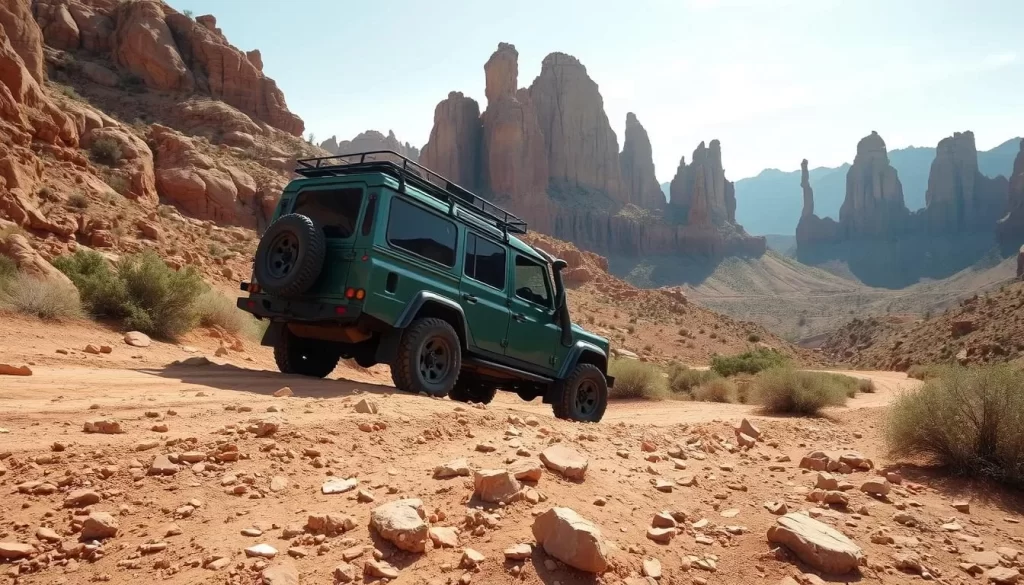
The Cathedral Valley Loop is a 58-mile backcountry driving route that showcases some of the most spectacular landscapes in Capitol Reef National Park. Along the way, you’ll encounter surreal landscapes like the Bentonite Hills, with their multicolored clay formations.
Temple of the Sun and Moon
The Temple of the Sun and Moon is one of the iconic formations you’ll encounter on your journey through Cathedral Valley. This natural wonder is a must-see, with its unique rock formations that evoke a sense of awe.
Cathedral Valley Loop Drive
The Cathedral Valley Loop Drive is an adventure that spans 58 miles, requiring a high-clearance vehicle and preferably a 4WD setup. The drive begins with a river ford across the Fremont River and continues through a diverse landscape of badlands, monoliths, and expansive desert vistas.
As you drive along the way, take time to appreciate the unique geological formations and perhaps stop for a short hike. The remote nature of this drive ensures an intimate wilderness experience, far from the more developed areas of Capitol Reef.
Loop the Fold: A Backcountry Adventure
Embark on a thrilling backcountry adventure in Capitol Reef National Park by looping the fold. This journey takes you through some of the park’s most spectacular landscapes, showcasing the unique geological formations and diverse wildlife of the area.
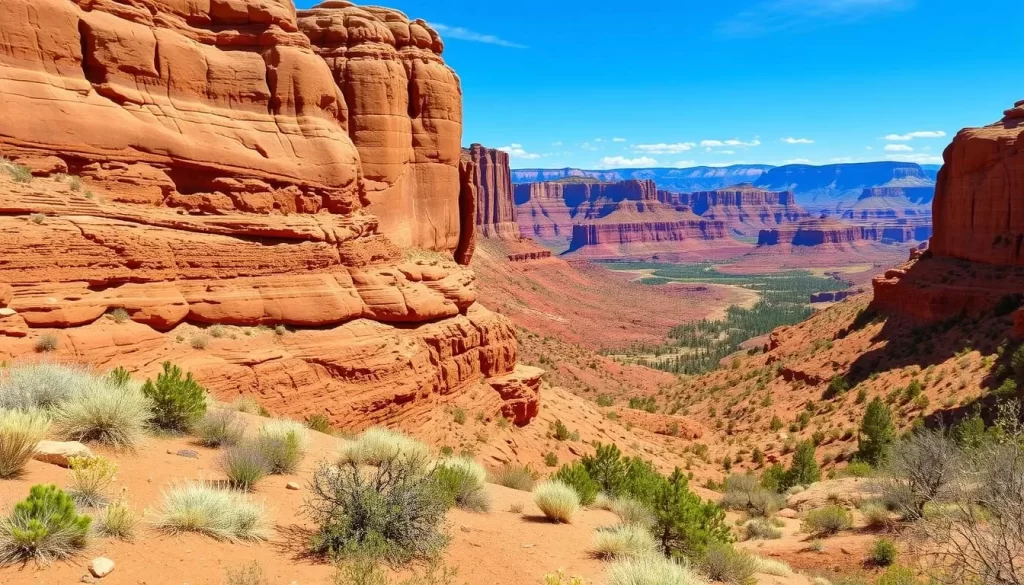
Burr Trail Switchbacks
The Burr Trail is a significant part of the Loop the Fold adventure, featuring challenging switchbacks that test your hiking skills. As you ascend, the panoramic views of the surrounding landscape unfold, making the effort worthwhile.
The Burr Trail Switchbacks are not for the faint of heart; they require a good level of physical fitness and offer an immersive experience into the rugged beauty of Capitol Reef National Park.
Strike Valley Overlook
One of the highlights of the Loop the Fold adventure is the Strike Valley Overlook, which offers breathtaking views of the Waterpocket Fold. This viewpoint is considered one of the most spectacular in Capitol Reef National Park, providing a glimpse into the geological history of the area.
The overlook is accessible via a 1.9-mile round-trip hike from the end of a rough 3-mile spur road that branches off the Burr Trail. The panoramic view from the top reveals the dramatic tilt of the rock layers, a testament to the powerful geological forces that shaped this landscape.
Hidden Gems: Slot Canyons and Lesser-Known Trails
For those willing to venture off the beaten path, Capitol Reef National Park offers an array of hidden treasures. While the park’s popular attractions draw many visitors, its lesser-known trails and slot canyons provide a unique and unforgettable experience.
Headquarters and Surprise Canyons
The Headquarters and Surprise Canyons are a pair of hidden gems within Capitol Reef National Park. These canyons offer a glimpse into the park’s diverse geological history and provide an opportunity for exploration off the beaten path. The hike through these canyons is a lesser-known adventure that showcases the park’s natural beauty.
Sulphur Creek Route
The Sulphur Creek Route is a 5.8-mile one-way hike that follows the creek through a spectacular canyon. This adventure is reminiscent of Zion National Park’s famous Narrows but with far fewer people. Hikers will need to wade through water, scramble around waterfalls, and use basic route-finding skills. The journey offers a unique perspective on the park’s geological features, including the underside of the Goosenecks Overlook.
| Trail Name | Distance | Notable Features |
|---|---|---|
| Sulphur Creek Route | 5.8 miles one-way | Waterfalls, narrows, Goosenecks Overlook |
| Headquarters and Surprise Canyons | Varies | Geological formations, hidden canyons |
Exploring these hidden gems not only provides a more secluded experience but also allows visitors to appreciate the natural beauty of Capitol Reef National Park in a new light. Whether you’re hiking through the Sulphur Creek Route or discovering the secrets of Headquarters and Surprise Canyons, these adventures are sure to leave a lasting impression.
Conclusion: Making the Most of Your Capitol Reef Adventure
Capitol Reef National Park offers an unforgettable adventure, filled with breathtaking natural beauty and rich cultural heritage. As you’ve discovered, this Utah gem is packed with exciting things to do, from exploring the scenic drives and hiking trails to experiencing the local cuisine and history.
Your visit toCapitol Reef National Parkcan be a truly immersive experience. With so much to see and do, it’s recommended to spend at least three days here to explore the main attractions likeHickman Bridge,Cassidy Arch, and theScenic Drive. Venture into remote areas likeCathedral Valleyor take on theBurr Trailfor a more adventurous experience.
Don’t miss the cultural aspects of the park, including ancientpetroglyphsand pioneer history in theFruita district. These add a rich layer to the natural beauty surrounding you. Consider visitingCapitol Reefas part of a larger Utah national parks road trip, includingZion,Bryce Canyon,Arches, andCanyonlands. This will give you a well-rounded experience of Utah’s natural wonders.
Whether you’re interested inhiking,photography,geology, or simply taking in the views,Capitol Reef National Parkhas something for everyone. With its less crowded trails and scenic drives, it’s an ideal destination for those seeking a peaceful yet adventurous getaway.
As you plan your trip, remember to check out theSunset PointandPanorama Pointfor breathtaking views. With its diverse landscapes and activities,Capitol Reefwill leave you planning your return visit before you’ve even left.
The above is subject to change.
Check back often to TRAVEL.COM for the latest travel tips and deals.
